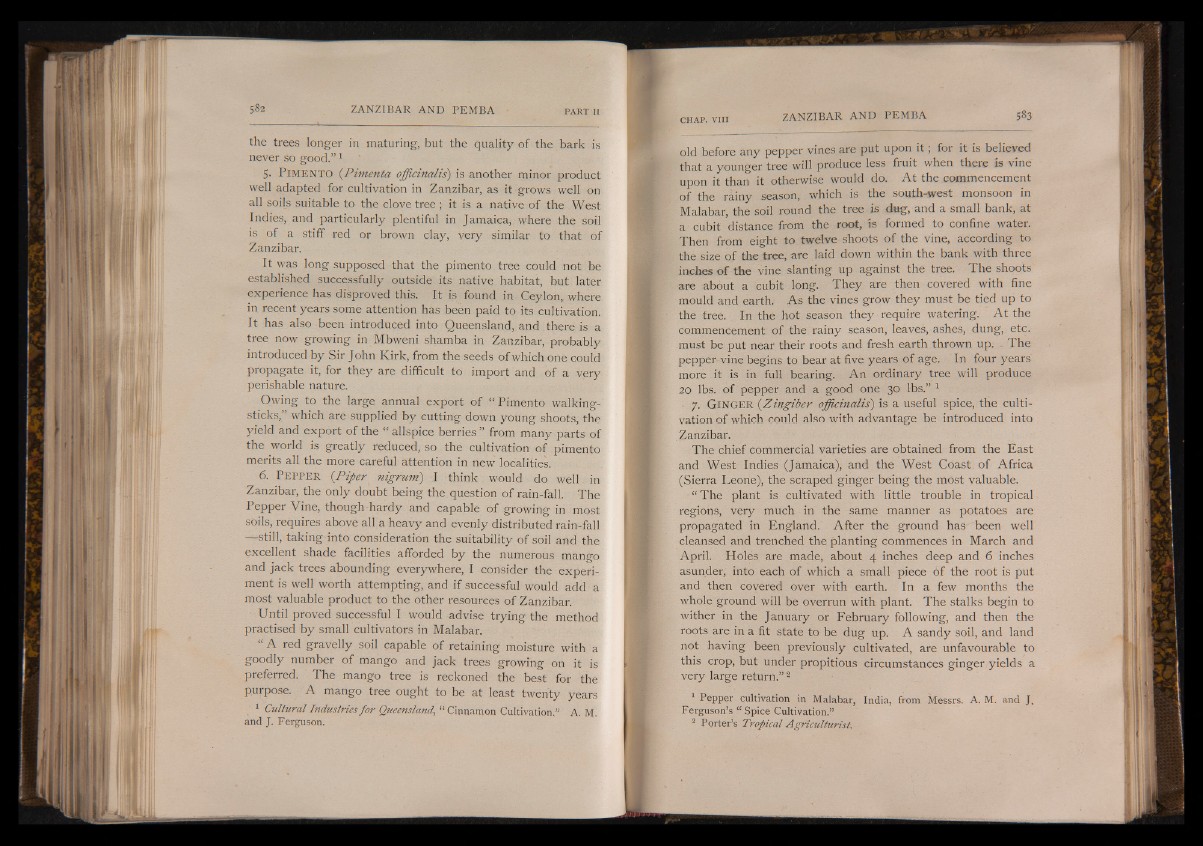
the trees longer in maturing, but the quality of the bark is
never so good.” 1
5. PIMENTO (.Pimento, officinalis) is another minor product
well adapted for cultivation in Zanzibar, as it grows well on
all soils suitable to the clove tree; it is a native of the West
Indies, and particularly plentiful in Jamaica, where the soil
is of a stiff red or brown clay, very similar to that of
Zanzibar.
It was long supposed that the pimento tree could not be
established successfully outside its native habitat, but later
experience has disproved this. It is found in Ceylon, where
in recent years some attention has been paid to its cultivation.
It has also been introduced into Queensland, and there is a
tree now growing in Mbweni shamba in Zanzibar, probably
introduced by Sir John Kirk, from the seeds of which one could
propagate it, for they are difficult to import and of a very
perishable nature.
Owing to the large annual export of “ Pimento walking-
sticks,” which are supplied by cutting down young shoots, the
yield and export of the “ allspice berries ” from many parts of
the world is greatly reduced, so the cultivation of pimento
merits all the more careful attention in new localities.
6. P e p p e r (Piper nigrum) I think would do well in
Zanzibar, the only doubt being the question of rain-fall. The
Pepper Vine, though hardy and capable of growing in most
soils, requires above all a heavy and evenly distributed rain-fall
— still, taking into consideration the suitability of soil and the
excellent shade facilities afforded by the numerous mango
and jack trees abounding everywhere, I consider the experiment
is well worth attempting, and if successful would add a
most valuable product to the other resources of Zanzibar.
Until proved successful I would advise trying the method
practised by small cultivators in Malabar.
“ A red gravelly soil capable of retaining moisture with a
goodly number of mango and jack trees growing on it is
preferred. The mango tree is reckoned the best for the
purpose. A mango tree ought to be at least twenty years
1 Cultural Industries fo r Queensland,\ “ Cinnamon Cultivation." A. M.
and J. Ferguson.
old before any pepper vines are put upon i t ; for it is believed
that a younger tree will produce less fruit when there is vine
upon it than it otherwise would do. At the commencement
of the rainy season, which is the south-west monsoon in
Malabar, the soil round the tree is dug, and a small bank, at
a cubit distance from the root, is formed to confine water.
Then from eight to twelve shoots of the vine, according to
the size of the tree, are laid down within the bank with three
inches of the vine slanting up against the tree. The shoots
are about a cubit long. They are then covered with fine
mould and earth. As the vines grow they must be tied up to
the tree. In the hot season they require watering. A t the
commencement of the rainy season, leaves, ashes, dung, etc.
must be put near their roots and fresh earth thrown up. The
pepper vine begins to bear at five years of age. In four years
more it is in full bearing. An ordinary tree will produce
20 lbs. of pepper and a good one 30 lbs.” 1
7. GINGER (.Zingiber officinalis) is a useful spice, the cultivation
of which could also with advantage be introduced into
Zanzibar.
The chief commercial varieties are obtained from the East
and West Indies (Jamaica), and the West Coast of Africa
(Sierra Leone), the scraped ginger being the most valuable.
a The plant is cultivated with little trouble in tropical
regions, very much in the same manner as potatoes are
propagated in England. After the ground hasMjeen well
cleansed and trenched the planting commences in March and
April. Holes are made, about 4 inches deep and 6 inches
asunder, into each of which a small piece of the root is put
and then covered over with earth. In a few months the
whole ground will be overrun with plant. The stalks begin to
wither in the January or February following, and then the
roots are in a fit state to be dug up. A sandy soil, and land
not having been previously cultivated, are unfavourable to
this crop, but under propitious circumstances ginger yields a
very large return.” 2
1 Pepper cultivation in Malabar, India, from Messrs. A. M. and J,
Ferguson’s “ Spice Cultivation.”
2 Porter’s Tropical Agriculturist.